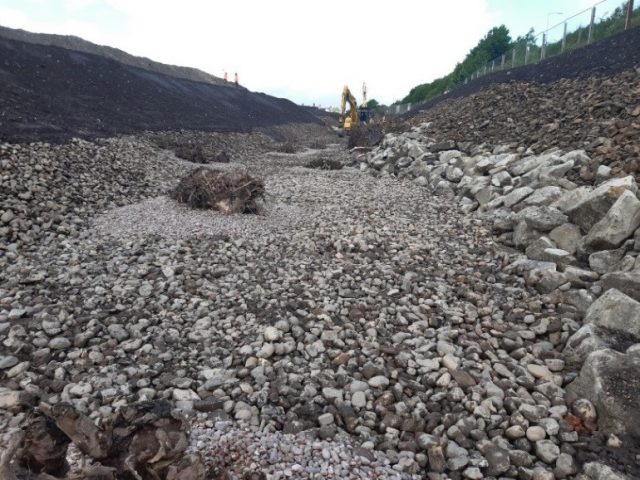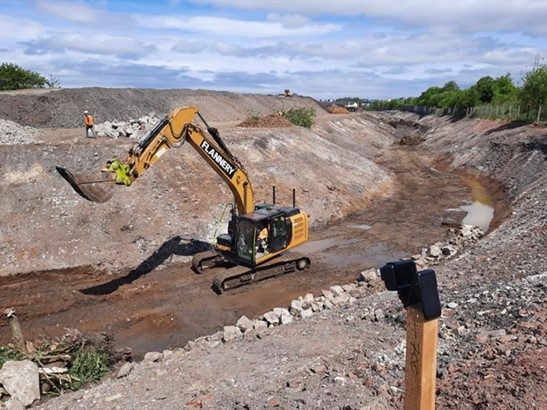
Matt Lawrence, EA Project Executive for the SUNRISE programme, discusses a project to divert part of the River Trent through the former Stoke City ground
The River Trent: England's third longest river, rising just a few miles outside of Stoke-on-Trent. Parts of the Trent see populations of wild brown trout, otters and kingfishers, and Stoke-on-Trent has been recognised as one of the top cities for green spaces in Britain. However, in some parts of the city, you’d hardly notice that the iconic river, from which the city takes its name, is there. We’re working to change that.
It's unusual for the headwaters of a river to begin in a major urban conurbation, this means that the river gets off to a challenging start as decades of urbanisation have taken their toll on its water quality and ecology.
Before the Industrial Revolution, the headwaters of the Trent supported a thriving salmon fishery, but the pollution from new industries and sewage discharges from the rapid population increase, as pottery factories sprang up around the area, meant a massive and serious decline in the quality of the Trent and its tributaries. Fish disappeared from the river and pollution became so dreadful that in 1905 the Duke of Sutherland (the then owner of the nearby Trentham Estate) described the river as being an “intolerable nuisance” and of having a "most foul and offensive stench”.
With kingfishers, brown trout and otters now a common sight in some parts, it is much improved since the boom of the Industrial Revolution, and while Stoke-on-Trent is one of the top cities for green spaces in Britain, the iconic Trent is not always the pride of the city.
Nowhere is that more self-evident than where the Trent makes its way through the Victoria ground, former home of Stoke City Football Club, along a dismal concrete channel, devoid of the habitat needed to support aquatic life. Since the club relocated to the Britannia Stadium in the late 90s, the old football ground has stood a derelict and sad sight alongside the A500 spine road which links two junctions of the M6.
But once the stamping ground of Sir Stanley Matthews, the Victoria ground is now being transformed as work progresses to develop a new river channel through the ground. Where players and fans once endured the highs and lows of the beautiful game, a new kind of beauty is being created.

This ambitious scheme is the flagship project of 16 separate pieces of work under the SUNRISE (Stoke and Newcastle Rediscovering its Secret Environment) programme. The £3.6m programme is funded by the European Regional Development Fund (ERDF) with contributions from the Environment Agency and other partners.
The SUNRISE project is seeing a rebirth of the Trent on the horizon, after project partners, the Environment Agency, Staffordshire Wildlife Trust and Stoke-on-Trent City Council, and site owners St Modwen, joined forces to carve out a new future for the river.
Work is currently progressing to dig a new 500m channel through the site, connecting the new stretch of river to an area upstream which is in much better shape. Instead of a straight river encased in concrete, a more naturalised channel is being created, with work expected to finish in December this year. A new footpath adjacent to the river channel will be built and opened a year or so later to allow the local community to enjoy the wildlife that the new river channel will attract; reconnecting communities with both green spaces and watercourses is another aim of the SUNRISE programme.
SUNRISE is supported with funding through our Environment Programme. Moving a river is no easy task and the project has taken many years of hard work to get to this point. I was proud to represent all my colleagues who have helped make the project happen when the new river diversion was featured on a recent episode of “Countryfile.”
For the residents of Stoke-on-Trent, and for wildlife, this is an imaginative and inspiring use of a derelict brownfield site. Where once the noise of fans rang out on a Saturday afternoon, it’s hoped it will soon be the plop of fish swimming and whistle of birdsong filling the air instead. And, we will all take on responsibility for ensuring this new stretch of the Trent is protected for generations to come.
To keep updated you can follow progress on Twitter @Wildstoke or at http://www.erdf-sunrise.co.uk/

Leave a comment